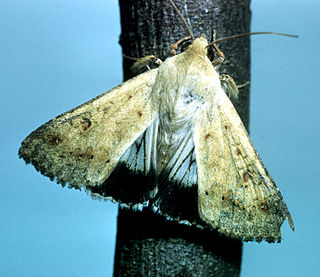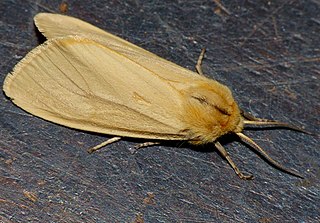
Heliothis is a genus of moths in the family Noctuidae. It was first described by Ferdinand Ochsenheimer in 1816. Some of the species have larvae which are agricultural pests on crop species such as tobacco, cotton, soybean and pigeon pea. Some species originally in this genus have been moved to other genera, see Chloridea and Helicoverpa.

Bleninae is a monotypic subfamily of the moth family Nolidae. Its single genus, Blenina, was erected by Francis Walker in 1858.

Eublemma anachoresis, the banner, is a moth of the family Erebidae. The species was first described by Hans Daniel Johan Wallengren in 1863. It is found in the Indomalayan realm, Australia and the southern part of Africa. Records include Fiji, Hong Kong, India, Sri Lanka, Japan, the Society Islands, Eswatini, Taiwan, Thailand and northern New South Wales and Queensland in Australia.

Nepita is a monotypic moth genus in the subfamily Arctiinae erected by Frederic Moore in 1860. Its only species, Nepita conferta, the footman moth, was first described by Francis Walker in 1854. It is found in India and Sri Lanka.

Helicoverpa punctigera, the native budworm, Australian bollworm or Chloridea marmada, is a species of moth in the family Noctuidae. This species is native to Australia. H. punctigera are capable of long-distance migration from their inland Australian habitat towards coastal regions and are an occasional migrant to New Zealand.

Saenura is a genus of moth in the subfamily Arctiinae. It contains only one species, Saenura flava, which can be found in southern Africa.

Hypocala is a genus of moths of the family Erebidae first described by Achille Guenée in 1852.

The Erebidae are a family of moths in the superfamily Noctuoidea. The family is among the largest families of moths by species count and contains a wide variety of well-known macromoth groups. The family includes the underwings (Catocala); litter moths (Herminiinae); tiger, lichen, and wasp moths (Arctiinae); tussock moths (Lymantriinae), including the arctic woolly bear moth ; fruit-piercing moths ; micronoctuoid moths (Micronoctuini); snout moths (Hypeninae); and zales, though many of these common names can also refer to moths outside the Erebidae. Some of the erebid moths are called owlets.

Rufoclanis numosae, the wavy polyptychus, is a moth of the family Sphingidae. The species was first described by Hans Daniel Johan Wallengren in 1860. It is known from dry bush and arid savanna in much of eastern and southern Africa.

Ceryx anthraciformis is a moth of the subfamily Arctiinae. It was described by Wallengren in 1860. It is found in South Africa.
Ceryx morobeensis is a moth of the subfamily Arctiinae. It was described by Obraztsov in 1957. It is found in New Guinea.
Ceryx mirabilis is a moth of the subfamily Arctiinae. It was described by Peter Smetacek in 2010. It is found in India.
Eilema gracilipennis is a moth of the subfamily Arctiinae. It was described by Wallengren in 1860. It is found in the Democratic Republic of Congo, Kenya, South Africa and Uganda.

Euchromia polymena is a species of day flying moth of the subfamily Arctiinae. These moths are vibrantly coloured and look like wasps so known as Wasp moth or Painted handmaiden moth. It was described by Carl Linnaeus in his 1758 10th edition of Systema Naturae. It is found in India and south-eastern Asia, as well as on Sumatra, Java, Sulawesi, Peninsular Malaysia, Borneo and the Philippines. It is also present in the northern part of Western Australia and the Northern Territory.
Halone sinuata, the rock lichen moth, is a moth of the subfamily Arctiinae. It was described by Hans Daniel Johan Wallengren in 1860. It is found in Australia.
Phryganopsis cinerella is a moth in the subfamily Arctiinae. It was described by Wallengren in 1860. It is found in Kenya, Mozambique, Niger, Nigeria, Sierra Leone, South Africa and Zimbabwe.
Poliopastea obscura is a moth in the subfamily Arctiinae. It was described by Wallengren in 1860. It is found on Saint Lucia and in Ecuador.

Marmaroplegma paragarda, the speared monkey, is a moth in the family Eupterotidae. It was described by Wallengren in 1860. It is found in South Africa and Zimbabwe.












